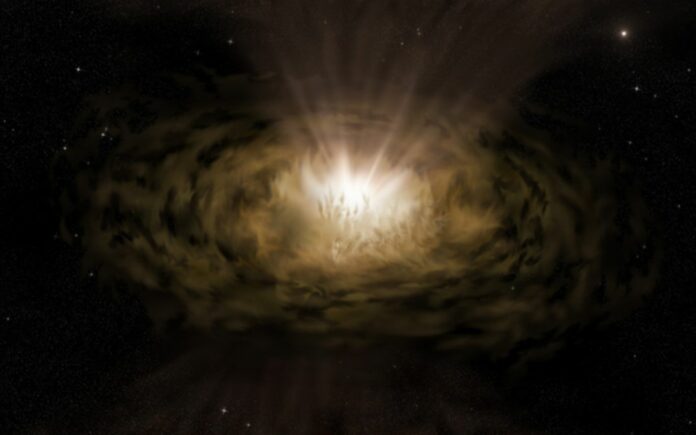These new findings simplify the work of researchers and accelerate our understanding of “what happens as black holes swallow material.”
Active galactic nuclei, which are powered by supermassive black holes consuming matter in galaxy centers, are the strongest steady sources of energy in the universe. These nuclei have always been recognized to be far brighter than the light of billions of stars in their host galaxies.
However, a recent study suggests that scientists have significantly underestimated their energy output due to not taking into account the extent to which dust dims their light.
Martin Gaskell, a research associate in astronomy and astrophysics at UC Santa Cruz, explains that when small particles are present in the line of sight, it makes objects behind them appear dimmer.
This effect can be observed at sunset on a clear day when the sun appears fainter.
Gaskell is the lead author of a recent paper on these new findings, published in the Monthly Notices of the Royal Astronomical Society.
Although the potential impact of dust on the light emitted by active galactic nuclei has been acknowledged for some time, the extent of this impact was widely considered to be minimal.
However, the research shows that this is not the case and that the far ultraviolet light emitted by these nuclei is significantly dimmed by dust.
The research team arrived at this conclusion by analyzing the impact of dust on the light emitted by one of the most well-studied active galactic nuclei, known as NGC 5548. Similar to how dust in the Earth’s atmosphere causes the sun to appear redder and dimmer at sunset, dust in active galactic nuclei also causes them to appear redder than they actually are.
The degree of reddening is directly correlated to the amount of dimming. Scientists measure the colors of an object by determining the ratio of light intensity at different wavelengths.
While the unreddened color of the sun is well known, there has been considerable debate surrounding the unreddened colors of active galactic nuclei. This is because, while theories suggest intrinsic colors, it was uncertain if these theories were applicable to active galactic nuclei.
The study of NGC 5548 by UCSC researchers utilized seven different indicators of dust and found them to be consistent. Additionally, the dimming of NGC 5548 caused by dust was found to be significant, more than ten times greater than the dimming caused by dust in our own galaxy, the Milky Way.
“The good agreement between the different indicators of the amount of reddening was a pleasant surprise,” adds Gaskell. “It strongly supports simple theories of emission from active galactic nuclei. Exotic explanations of colors are not needed. This makes life simpler for researchers and is speeding up our understanding of what happens as black holes swallow material.”
According to Gaskell, the colors of NGC 5548 are representative of other active galactic nuclei, which has significant implications. The dimming effects of dust cause active galactic nuclei to be even more powerful than previously understood.
The research implies that in the ultraviolet, where most of the energy is emitted, a typical active galactic nucleus is producing an order of magnitude more energy than previously believed.
Additionally, the results suggest that active galactic nuclei are quite similar and that what were previously thought to be major fundamental differences between them are actually just the result of varying degrees of reddening caused by dust.
Image Credit: Peter Z. Harrington
